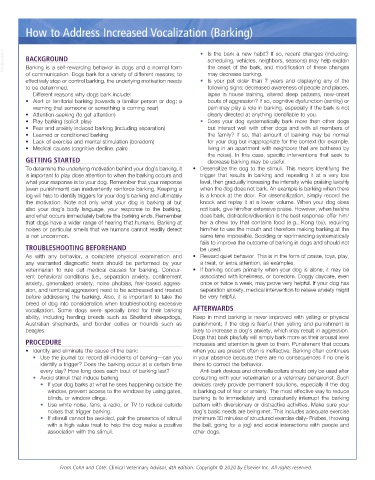Page 3195 - Cote clinical veterinary advisor dogs and cats 4th
P. 3195
How to Address Increased Vocalization (Barking)
VetBooks.ir BACKGROUND • Is the bark a new habit? If so, recent changes (including:
scheduling, vehicles, neighbors, seasons) may help explain
the onset of the bark, and modification of these changes
Barking is a self-rewarding behavior in dogs and a normal form
of communication. Dogs bark for a variety of different reasons; to may decrease barking.
effectively stop or control barking, the underlying motivation needs • Is your pet older than 7 years and displaying any of the
to be determined. following signs: decreased awareness of people and places,
Different reasons why dogs bark include: lapse in house training, altered sleep patterns, new-onset
• Alert or territorial barking (towards a familiar person or dog; a bouts of aggression? If so, cognitive dysfunction (senility) or
warning that someone or something is coming near) pain may play a role in barking, especially if the bark is not
• Attention-seeking (to get attention) clearly directed at anything identifiable to you.
• Play barking (solicit play) • Does your dog systematically bark more than other dogs
• Fear and anxiety induced barking (including separation) but interact well with other dogs and with all members of
• Learned or conditioned barking the family? If so, that amount of barking may be normal
• Lack of exercise and mental stimulation (boredom) for your dog but inappropriate for the context (for example,
• Medical causes (cognitive decline, pain) living in an apartment with neighbors that are bothered by
the noise). In this case, specific interventions that seek to
GETTING STARTED decrease barking may be useful.
To determine the underlying motivation behind your dog’s barking, it • Desensitize the dog to the stimuli. This means identifying the
is important to play close attention to when the barking occurs and trigger that results in barking and repeating it at a very low
what your response is to your dog. Remember that your response level, then gradually increasing the intensity while praising lavishly
(even punishment) can inadvertently reinforce barking. Keeping a when the dog does not bark. An example is barking when there
log will help to identify triggers for your dog’s barking and ultimately is a knock at the door. For desensitization, simply record the
the motivation. Note not only what your dog is barking at but knock and replay it at a lower volume. When your dog does
also your dog’s body language, your response to the barking, not bark, give him/her extensive praise. However, when he/she
and what occurs immediately before the barking ends. Remember does bark, distraction/diversion is the best response: offer him/
that dogs have a wider range of hearing that humans. Barking at her a chew toy that contains food (e.g., Kong toy), requiring
noises or particular smells that we humans cannot readily detect him/her to use the mouth and therefore making barking at the
is not uncommon. same time impossible. Scolding or reprimanding systematically
fails to improve the outcome of barking in dogs and should not
TROUBLESHOOTING BEFOREHAND be used.
As with any behavior, a complete physical examination and • Reward quiet behavior. This is in the form of praise, toys, play,
any warranted diagnostic tests should be performed by your a treat, or extra attention, as examples.
veterinarian to rule out medical causes for barking. Concur- • If barking occurs primarily when your dog is alone, it may be
rent behavioral conditions (i.e., separation anxiety, confinement associated with loneliness, or boredom. Doggy daycare, even
anxiety, generalized anxiety, noise phobias, fear-based aggres- once or twice a week, may prove very helpful. If your dog has
sion, and territorial aggression) need to be addressed and treated separation anxiety, medical intervention to relieve anxiety might
before addressing the barking. Also, it is important to take the be very helpful.
breed of dog into consideration when troubleshooting excessive
vocalization. Some dogs were specially bred for their barking AFTERWARDS
ability, including herding breeds such as Shetland sheepdogs, Keep in mind barking is never improved with yelling or physical
Australian shepherds, and border collies or hounds such as punishment; if the dog is fearful then yelling and punishment is
beagles. likely to increase a dog’s anxiety, which may result in aggression.
Dogs that bark playfully will simply bark more as their arousal level
PROCEDURE increases and attention is given to them. Punishment that occurs
• Identify and eliminate the cause of the bark: when you are present often is ineffective. Barking often continues
• Use the journal to: record all incidents of barking—can you in your absence because there are no consequences if no one is
identify a trigger? Does the barking occur at a certain time there to correct the behavior.
every day? How long does each bout of barking last? Anti-bark devices and citronella collars should only be used after
• Avoid stimuli that induce barking consulting with your veterinarian or a veterinary behaviorist. Such
• If your dog barks at what he sees happening outside the devices rarely provide permanent solutions, especially if the dog
window, prevent access to the windows by using gates, is barking out of fear or anxiety. The most effective way to reduce
blinds, or window clings. barking is to immediately and consistently interrupt the barking
• Use white noise, fans, a radio, or TV to reduce outside pattern with diversionary or distractive activities. Make sure your
noises that trigger barking. dog’s basic needs are being met. This includes adequate exercise
• If stimuli cannot be avoided, pair the presence of stimuli (minimum 30 minutes of structured exercise daily- Frisbee, throwing
with a high value treat to help the dog make a positive the ball, going for a jog) and social interactions with people and
association with the stimuli. other dogs.
From Cohn and Côté: Clinical Veterinary Advisor, 4th edition. Copyright © 2020 by Elsevier Inc. All rights reserved.

